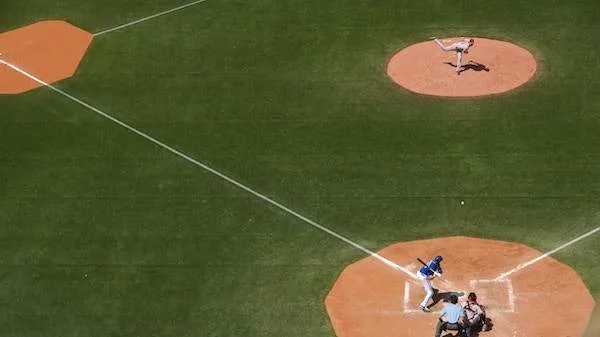Looking for an On-Base plus Slugging Calculator? We have an awesome, easy-to-use OPS Calculator below that helps you quickly figure out what your On-base plus Slugging. Plus, we have a guide on understanding OPS and how to improve your OPS score.
OPS Calculator ⚾️
The Ultimate Guide to the OPS Calculator: Understanding and Improving Your On-Base Plus Slugging ⚾️
Welcome to the world of baseball and softball statistics!
If you’re a player, coach, fan, or fantasy baseball manager, you know that numbers play a huge role in understanding the game.
One of the most important stats in baseball and softball is OPS, which stands for On-Base Plus Slugging. But what exactly is OPS, and how can you calculate it? That’s where the OPS Calculator comes in!
In this ultimate guide, we’ll introduce you to the OPS Calculator, show you how to use it, and dive into the nitty-gritty of OPS calculations.
We’ll also explore the differences between OPS, OBP, and other key stats.
Along the way, we’ll look at examples of great OPS values throughout history and share tips on how to improve your OPS. So, let’s get started!

Introducing the OPS Calculator
OPS is a powerful metric that combines a player’s ability to get on base (OBP) with their ability to hit for power (SLG).
It’s used by baseball and softball enthusiasts to evaluate offensive performance. But calculating OPS by hand can be tricky.
That’s why we created the OPS Calculator—a handy tool that does the math for you!
Our OPS Calculator is user-friendly and perfect for players, coaches, and fans.
Whether you’re analyzing your favorite MLB player or tracking your own performance in a softball league, this calculator has you covered. And guess what? It’s also a fantastic softball batting average calculator!

How to Use the OPS Calculator
Using the OPS Calculator is super easy!
Simply enter the required stats, including: hits, walks, hit by pitch, at-bats, singles, doubles, triples, home runs, and sacrifice flies. Then, hit the “Calculate OPS” button, and voilà! You’ll see your OPS value displayed on the screen.
But wait, there’s even more!
On our website, you’ll find other related baseball tools and calculators, such as:
- ERA Calculator
- Batting Average Calculator
- On Base Percentage Calculator
- RBI & SLG Calculator
- Random MLB Team Generator
So please feel free to explore, figure out all of your stats, and elevate your baseball as well as softball knowledge!

How to Calculate OPS
Now, let’s break down how OPS is calculated. OPS is the sum of two components: On-Base Percentage (OBP) and Slugging Percentage (SLG). Here’s the formula:
OPS = OBP + SLG
OBP measures how often a player reaches base, while SLG measures their power hitting. By combining these two, OPS gives us a comprehensive view of a player’s offensive prowess.
The Difference between OPS, OBP, and Other Key Baseball Stats
You might be wondering how OPS differs from other stats. Let’s compare:
- OPS: Combines on-base ability and power hitting.
- OBP: Focuses solely on a player’s ability to reach base.
- Batting Average: Measures how often a player gets a hit but doesn’t account for walks or power.
- SLG: Measures power hitting but doesn’t consider on-base ability.
- RBI: Represents runs batted in, which is team-dependent.
As you can see, OPS is unique because it captures both on-base ability and power in one metric.
Examples of OPS, and Great Ones Throughout History
So, what’s a good OPS value? Here’s a rough guide:
- Below .700: Below average
- .700 to .800: Average
- .800 to .900: Above average
- .900 to 1.000: Excellent
- Above 1.000: Outstanding
Throughout history, some players have achieved legendary OPS values. The following are standouts. Their exceptional on-base and power-hitting abilities earned them a place in the record books and the admiration of fans.
The Top Ten Players with the Best Career OPS:
| Babe Ruth | 1.164 (1.1636) | 1 |
| Ted Williams | 1.115 (1.1155) | 2 |
| Lou Gehrig | 1.080 (1.0798) | 3 |
| Barry Bonds | 1.051 (1.0512) | 4 |
| Jimmie Foxx | 1.038 (1.0376) | 5 |
| Hank Greenberg | 1.017 (1.0169) | 6 |
| Rogers Hornsby | 1.010 (1.0103) | 7 |
| Mike Trout | 1.000 (.99988) | 8 |
| Manny Ramirez | 0.996 (.99596) | 9 |
| Mark McGwire | 0.982 (.98232) | 10 |

How to Improve Your OPS
Improving your OPS means boosting both your OBP and SLG. Use the following tips:
- Improve Plate Discipline: Being selective at the plate can increase your chances of drawing walks and getting on base. Focus on swinging at good pitches and avoiding bad ones.
- Make Solid Contact: Consistently hitting the ball solidly can lead to more hits and extra-base hits. Practice your swing mechanics and aim for line drives.
- Increase Power: Strength training and proper hitting technique can help you hit for more power. Extra-base hits, especially doubles and home runs, boost your SLG.
- Study Pitchers: Understanding a pitcher’s tendencies can give you an edge at the plate. Look for patterns and anticipate the types of pitches you might see.
Remember, practice as well as dedication are key to improving your performance on the field.
The Impact of OPS on Player Evaluation and Team Performance
OPS is certainly a valuable tool for evaluating players. Therefore, if you’re interested in taking your baseball skills to the next level, or recruiting the next star of your team, you’ll need to frequently assess OPS.
Scouts, coaches, and analysts often use OPS to assess a player’s offensive contributions. That’s because a high OPS indicates a well-rounded hitter—and threat in the lineup—who can both reach base and hit for power.
In essence, teams with higher OPS scores tend to have more potent offenses—and often see more victories.
But let’s say you’re not a player or a coach. Well, you can also apply this same logic to you’re Fantasy Baseball league to outsmart your opponents!

Using the OPS Calculator for Fantasy Baseball
For fantasy baseball managers, OPS is a crucial stat!
It can certainly impact player rankings and draft decisions. As we mentioned in the section before, OPS is a stat that is highly correlated with a successful offense.
With the OPS Calculator, you can analyze players’ past performance and make informed choices for your fantasy team.
Of course, a well-rounded fantasy team with high OPS values can give you a competitive edge. So, use OPS to build a winning roster and outsmart your opponents!
In Conclusion: Use the OPS Calculator to Understand Your Performance
That’s a wrap! OPS is a powerful metric that captures the essence of offensive performance. And in this guide, we explored the ins and outs of it—including the OPS calculator, how to improve your OPS, great OPS throughout history, and how to use it for fantasy baseball.
So, go ahead and give the OPS Calculator a try! Analyze your favorite players, track your own stats, and deepen your appreciation for the game.
Also, don’t forget to check out our other baseball and softball tools to enhance your knowledge even further. Such as:
- ERA Calculator
- Batting Average Calculator
- On Base Percentage Calculator
- RBI & SLG Calculator
- Random MLB Team Generator